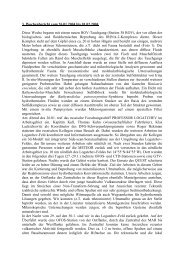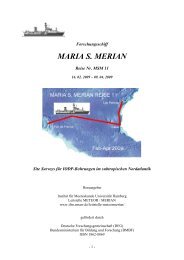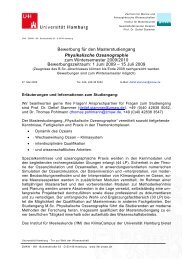MSM01_Expeditionsheft.pdf - Institute of Oceanography, University ...
MSM01_Expeditionsheft.pdf - Institute of Oceanography, University ...
MSM01_Expeditionsheft.pdf - Institute of Oceanography, University ...
Sie wollen auch ein ePaper? Erhöhen Sie die Reichweite Ihrer Titel.
YUMPU macht aus Druck-PDFs automatisch weboptimierte ePaper, die Google liebt.
Quecksilber-Gasaustausch zwischen Meer<br />
und Atmosphäre:<br />
Untersuchungen der Konzentrationen von<br />
elementarem Quecksilber (Hg°) in Atmosphäre<br />
und Oberflächenwasser weisen darauf<br />
hin, dass das Meer eine signifikante Quelle<br />
für atmosphärische Hg° darstellt. Regionale<br />
oder globale Flussbilanzen sind jedoch bislang<br />
nur sehr grob möglich und bedürfen der<br />
Verbesserung. Während der Reise soll ein<br />
am IOW entwickeltes Messsystem eingesetzt<br />
werden, mit dem der Hg°-Konzentrationsgradient<br />
an der Grenzfläche Meer/<br />
Atmosphäre mit zeitlicher Auflösung von<br />
ca. einer Stunde quasi-kontinuierlich<br />
gemessen werden kann. Hierdurch wird es<br />
möglich, großräumige winterliche Flussberechnungen<br />
für den Hg°-Austausch<br />
zwischen Ostsee und Atmosphäre vorzunehmen.<br />
Ein zweiter Schwerpunkt der Arbeiten<br />
wird darin liegen, die Bedeutung des sub-<br />
/anoxischen Tiefenwassers für die Bildung<br />
von Hg° zu untersuchen durch Bestimmungen<br />
des Hg°-Sättigungszustandes des<br />
Tiefenwassers.<br />
CO2-Flüsse und CO2-Speicherung in der<br />
Ostsee: Studien zum CO2- und Kohlenst<strong>of</strong>fkreislauf<br />
in der Ostsee wurden im wesentlichen<br />
in der östliche Gotlandsee durchgeführt<br />
und lassen keine Bewertung der<br />
gesamten Ostsee als CO2-Speicher und Umwälzpumpe<br />
für atmosphä-risches CO2 zu.<br />
Insbesondere die Rolle des Bottnische<br />
Meerbusen mit großer Ausdehnung und<br />
winterlicher Eisbedeckung bleibt unklar. Die<br />
geplanten Messungen sollen zu einer umfassenden<br />
CO2-/Kohlenst<strong>of</strong>f-Bilanz für die<br />
gesamte Ostsee beitragen. Im Rahmen des<br />
CANIBAL Projektes sind sie die erste von<br />
vier saisonalen Probennahmen zur Bestimmung<br />
des CO2-Inventars der Ostsee, des<br />
CO2-/Alkalinitäts-Eintrags über die Flüsse<br />
und des CO2-Aus-tauschs mit der Atmosphäre.<br />
Während der Reise soll weitgehend<br />
automatisierte Messungen des pCO2 im<br />
Oberflächenwass-ers kontinuierlich gemessen<br />
werden. Parallel dazu werden alle 30 –<br />
50 Seemeilen Proben für die CT- und AT-<br />
Analyse entnommen.<br />
- 9 -<br />
Mercury gas exchange between ocean and<br />
atmosphere:<br />
Investigations <strong>of</strong> elementary Hg° concentrations<br />
in the atmosphere and in the ocean<br />
indicate that the ocean is a significant<br />
source for atmospheric Hg°. Regional and<br />
global budgets, however, can only be<br />
roughly estimated ands need improvement.<br />
During the cruise a measuring system, developed<br />
by IOW, will be deployed to quasicontinuously<br />
assess Hg° concentration gradients<br />
at the ocean-atmosphere interface<br />
with an hour resolution. This will enable us<br />
to calculate fluxes from the Baltic Sea to the<br />
atmosphere on a broad spatial scale for<br />
winter conditions. Second emphasis will be<br />
laid the role <strong>of</strong> sub-/unoxic deep water for<br />
the formation <strong>of</strong> Hg°, by determining Hg<br />
concentrations/saturation within this water.<br />
CO2 fluxes and CO2 storage in the Baltic<br />
Sea: Past years studies <strong>of</strong> CO2 and carbon<br />
cycling mainly focused on the eastern Gotland<br />
Sea, hence not permitting the evaluation<br />
<strong>of</strong> the entire Baltic Sea as a storage or<br />
pump <strong>of</strong> atmospheric CO2. In particular the<br />
role <strong>of</strong> the Bothnian Sea and Bottenwiek<br />
with their large area and seasonal ice cover<br />
remain unclear as yet. Investigations during<br />
the cruise will contribute to a comprehensive<br />
CO2/ carbon budget for the entire Baltic<br />
Sea. In the framework <strong>of</strong> the CANIBAL Project<br />
this cruise is the first <strong>of</strong> four seasonal<br />
field campaigns to assess the CO2 inventory<br />
<strong>of</strong> the Baltic Sea, CO2 /alkalinity input via<br />
rivers and the CO2 exchange with the atmosphere.<br />
During cruise 1 a quasiautomatic<br />
device will be operated to continuously<br />
measure surface water pCO2, and<br />
samples will be taken every 30 – 50 nautical<br />
miles for analyses <strong>of</strong> total C and total<br />
alcalinity.



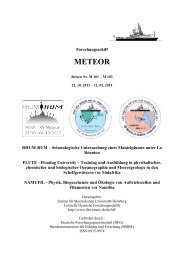

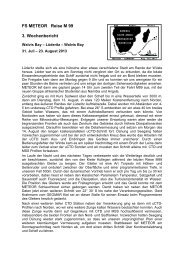
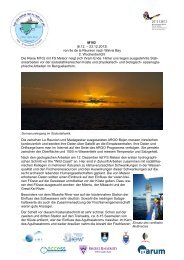
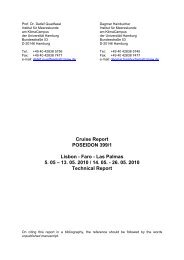
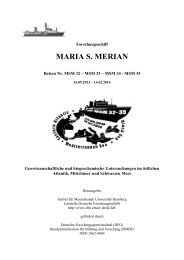
![Expeditionsheft Reisen M99-M100 [pdf] - Institute of Oceanography ...](https://img.yumpu.com/22533092/1/184x260/expeditionsheft-reisen-m99-m100-pdf-institute-of-oceanography-.jpg?quality=85)
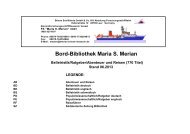
![Darstellungen [pdf]](https://img.yumpu.com/22533086/1/184x260/darstellungen-pdf.jpg?quality=85)



